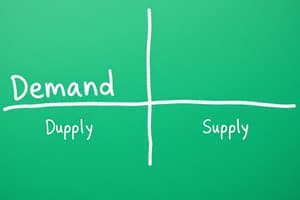Podcast
Questions and Answers
What is microeconomics and its primary focus?
What is microeconomics and its primary focus?
Microeconomics is the branch of economics that analyzes the behavior of individuals and firms in decision-making regarding resource allocation.
Explain the concepts of supply and demand.
Explain the concepts of supply and demand.
Supply refers to the quantity of a good producers are willing to sell at various prices, while demand is the quantity consumers are willing to purchase at those prices.
What is meant by market equilibrium?
What is meant by market equilibrium?
Market equilibrium is the point where the quantity supplied equals the quantity demanded.
Define price elasticity of demand and what it indicates about consumer behavior.
Define price elasticity of demand and what it indicates about consumer behavior.
How does understanding elasticity benefit businesses in pricing strategies?
How does understanding elasticity benefit businesses in pricing strategies?
Flashcards are hidden until you start studying
Study Notes
Microeconomics
-
Definition: Microeconomics is the branch of economics that analyzes the behavior of individuals and firms in making decisions regarding the allocation of scarce resources.
-
Key Concepts:
-
Supply and Demand: Fundamental principles that determine the price and quantity of goods in a market.
- Demand: The quantity of a good consumers are willing to purchase at various prices.
- Supply: The quantity of a good producers are willing to sell at various prices.
- Equilibrium: The point where supply equals demand.
-
Elasticity:
- Price Elasticity of Demand: Measures how much the quantity demanded responds to a change in price.
- Elastic (>1): Demand significantly changes with price change.
- Inelastic (<1): Demand changes little with price change.
- Income Elasticity: Measures how quantity demanded changes with consumer income.
- Price Elasticity of Demand: Measures how much the quantity demanded responds to a change in price.
-
Consumer Behavior:
- Utility: Satisfaction or pleasure derived from consuming goods and services.
- Marginal Utility: Additional satisfaction from consuming one more unit.
- Law of Diminishing Marginal Utility: As consumption increases, the additional satisfaction from each additional unit decreases.
- Utility: Satisfaction or pleasure derived from consuming goods and services.
-
Production and Costs:
- Factors of Production: Inputs used to produce goods and services (land, labor, capital).
- Short-run vs Long-run:
- Short-run: At least one input is fixed.
- Long-run: All inputs can be varied.
- Costs:
- Fixed Costs: Costs that do not change with production level.
- Variable Costs: Costs that change with production level.
- Total Cost: Sum of fixed and variable costs.
- Marginal Cost: Additional cost incurred from producing one more unit.
-
Market Structures:
- Perfect Competition: Many firms, homogeneous products, easy entry/exit.
- Monopoly: Single firm dominates the market, unique product, barriers to entry.
- Oligopoly: Few firms control the market, products may be identical or differentiated.
- Monopolistic Competition: Many firms, differentiated products, some control over price.
-
Market Failures:
- Situations where the allocation of goods and services is not efficient.
- Externalities: Costs or benefits not reflected in market prices (e.g., pollution).
- Public Goods: Non-excludable and non-rivalrous goods (e.g., national defense).
- Asymmetric Information: Situations where one party has more or better information than the other (e.g., in car sales).
-
Government Intervention:
- Price Controls: Regulations on prices (e.g., price ceilings and floors).
- Taxes and Subsidies: Affect market behavior and allocation of resources.
- Regulation: Rules set by government to control market activities.
-
-
Applications:
- Microeconomic principles apply to individual market analysis, consumer choice theory, pricing strategies, and resource allocation decisions.
-
Key Theorists:
- Alfred Marshall: Introduced concepts of supply and demand curves.
- Adam Smith: Known for the idea of the 'invisible hand' guiding market economies.
Microeconomics Overview
- Microeconomics studies individual and firm decision-making regarding scarce resource allocation.
- Focuses on how smaller economic units operate within a larger economy.
Supply and Demand
- Core principles that influence pricing and availability of goods in markets.
- Demand: Represents consumer willingness to purchase goods at different price levels.
- Supply: Reflects producers' readiness to sell goods at various prices.
- Equilibrium: Occurs at the intersection of supply and demand where the quantity of goods supplied equals the quantity demanded.
Elasticity
- Elasticity: Measures responsiveness of quantity demanded or supplied to changes in price.
- Price Elasticity of Demand:
- Elastic Demand (>1): Significant changes in quantity demanded due to price changes.
- Inelastic Demand (<1): Minimal changes in quantity demanded despite price fluctuations.
Studying That Suits You
Use AI to generate personalized quizzes and flashcards to suit your learning preferences.




